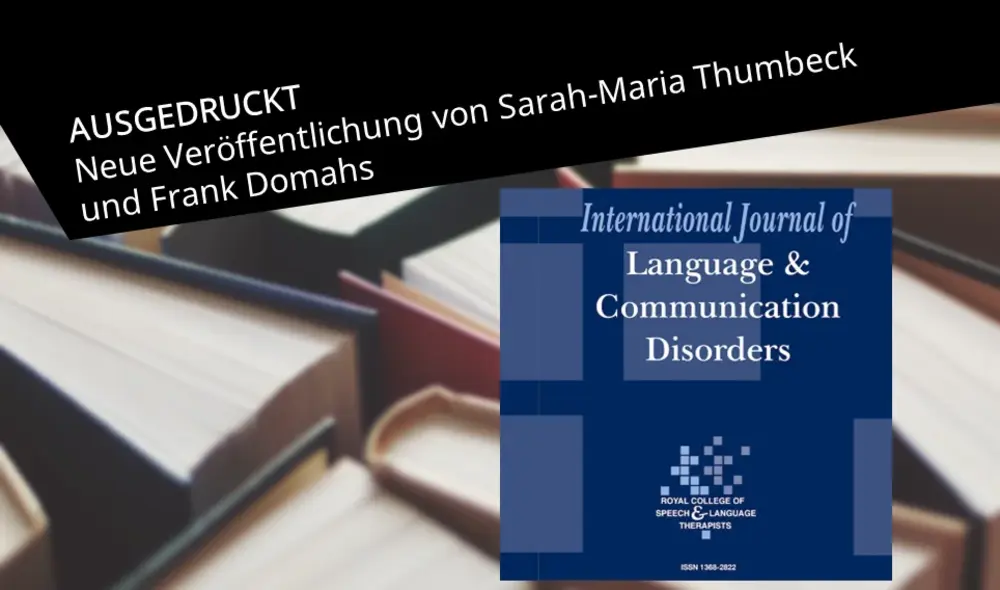Neue Veröffentlichung von Sarah-Maria Thumbeck und Frank Domahs

Lesestrategien können eingesetzt werden, um gelesene Informationen besser zu verstehen. Zunehmend werden Lesestrategien auch sprachtherapeutisch genutzt.
In der kürzlich veröffentlichten Studie Efficacy of reading strategies on text-level reading comprehension in people with post-stroke chronic aphasia: A repeated measures study untersuchten Sarah-Maria Thumbeck, Philipp Schmid, Sophie Chesneau und Frank Domahs die Wirkung von Lesestrategien bei 26 Menschen mit einer Aphasie. Nach einer Therapie mit Lesestrategien zeigten sich Verbesserungen im Textverständnis. Die Teilnehmer:innen zeigten außerdem eine positivere Einstellung zum Lesen und bemerkten Verbesserungen ihrer Lesefähigkeiten und bei der Ausübung von Leseaktivitäten.
Die Studie deutet darauf hin, dass Lesestrategien auch mit Menschen mit Aphasie in der Sprachtherapie genutzt werden können. Unklar ist bisher jedoch, welche individuellen Merkmale zum Behandlungserfolg beitragen.
Abstract
People with aphasia (PWA) frequently experience difficulties in understanding longer written content such as paragraphs or books. Reading strategies are a promising approach to treat text-level reading comprehension deficits in PWA. Nevertheless, empirical evidence for their efficacy remains rare. The primary objective of this study was to analyse the efficacy of a strategy-based intervention on text-level reading comprehension in PWA. Secondary objectives were to compare the effects of two strategy-based intervention components and to explore potential moderator effects.
A protocol was published prior to data acquisition. In a repeated measures trial, 26 German participants with chronic, post-stroke aphasia participated in a waiting period without aphasia treatment (control condition) followed by a strategy-based intervention called ‘Strategiebasierte Textverständnis-Therapie bei Aphasie’ (StraTexT, 14 face-to-face-sessions, twice per week, 60 min each). Two strategy combinations, Intervention Micro targeting microstructure and Intervention Macro targeting macrostructure, were applied to newspaper and magazine articles. Participants were randomly allocated to two parallel groups that received these strategy combinations in interchanged sequences. Assessments were implemented before and after each period as well as 3 and 6 months after the intervention. The primary outcome measure was text-level reading comprehension measured with the total score of a German version of the Test de Compréhension de Textes (TCT-D). Secondary outcome measures addressed the self-reported perception of reading abilities, reading activities and feelings about reading (German version of the Comprehensive Assessment of Reading in Aphasia CARA reading questionnaire) as well as selected cognitive functions.
The per-protocol-analysis included data from 22 participants. We found significant small improvements up to 6 months post-intervention compared to pre-intervention in the TCT-D Total (d = 0.35–0.46) as well as medium to large improvements in the CARA questionnaire (d = 0.68–0.96). Up to 3 months after the intervention, treatment-induced improvements in the TCT-D Total were significantly larger than change without treatment during the control condition. There was no evidence of moderator effects. Furthermore, we found improvements in several cognitive functions.
Reading strategies can lead to long-term improvements in text-level reading comprehension and in self-reported reading abilities, feelings about reading and reading activities in aphasia. In regular clinical settings, it seems reasonable to implement both Intervention Micro and Intervention Macro. It remains important to investigate participant characteristics that contribute to treatment success.
Thumbeck, S.-M., Schmid, P., Chesneau, S. & Domahs, F. (2023) Efficacy of reading strategies on text-level reading comprehension in people with post-stroke chronic aphasia: A repeated measures study. International Journal of Language & Communication Disorders, 00, 1–24. doi.org/10.1111/1460-6984.12983

